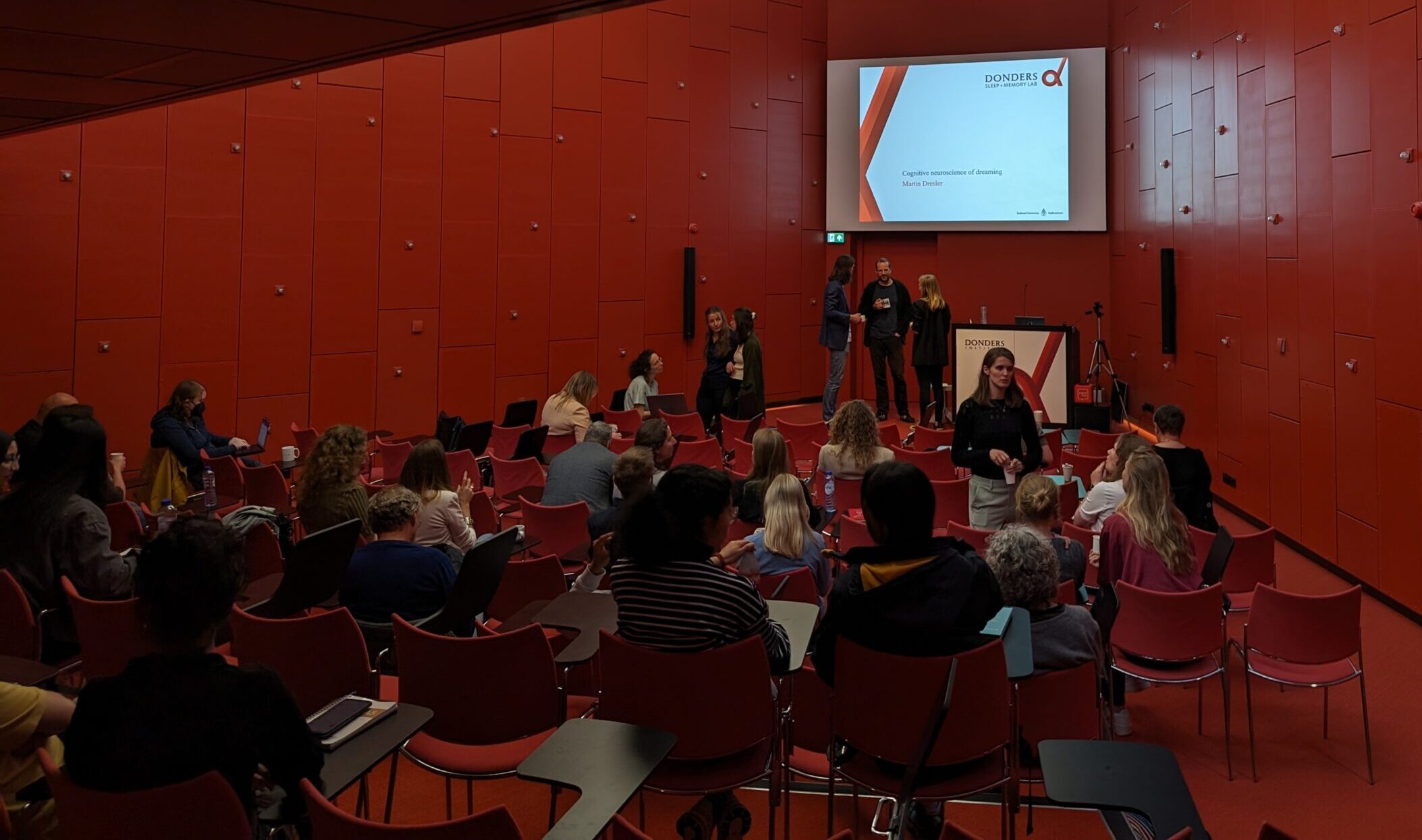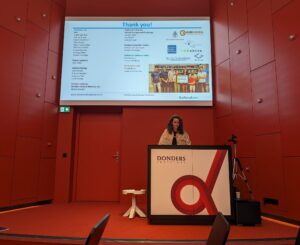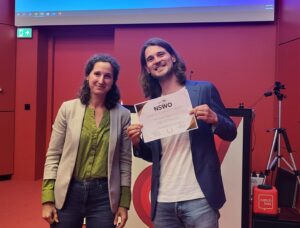
1 augustus, 2024
This 2024 spring symposium, hosted at the Donders Institute of Radboud University, featured snapshots of the diverse sleep-related research performed in Nijmegen and was organised together with SVNL.
Before the official start of the symposium, the NSWO member’s meeting took place with the debut of the new president, Annemarie Luik. For the first time, she took the stage to introduce herself to the members, marking the occasion with her inaugural use of the gavel. Her opening set a tone of enthusiasm and the members welcomed her.
The spring symposium featured a series of talks from various investigators from Nijmegen.
 1) Zebrafish as a Model to Assess Usher Syndrome-Related Sleep Deficits and Fatigue – Jessie Hendricks
1) Zebrafish as a Model to Assess Usher Syndrome-Related Sleep Deficits and Fatigue – Jessie Hendricks
Jessie Hendricks presented two interconnected topics on Usher syndrome, emphasising the neglect of sleep issues in this condition. She demonstrated that individuals with Usher syndrome experience highly variable sleep quality, unrelated to their visual impairment. In a zebrafish model, Hendricks found that “Usher” fish sleep more during the day compared to control fish, though their circadian rhythms appeared normal. Her talk highlighted the complementary and translational methods used to study sleep in Usher syndrome.
2) Sleep, Brain Clearance, and Neurodegeneration – Yevgenia Rozenblum
Yevgenia Rozenblum discussed the emerging topic of brain clearance during sleep, focusing on the removal of the amyloid beta protein. She described a unique study design that tracked amyloid beta fluctuations in blood plasma during sleep. Rozenblum’s findings indicated increased clearance of amyloid beta from the cerebrospinal fluid (CSF) to the blood after periods of slow-wave sleep, with decreased clearance following REM sleep.
3) Cognitive Neuroscience of Dreaming – Martin Dresler
Martin Dresler’s talk explored a century of sleep and dream research, showing the evolution of methods used to study these phenomena. He provided insights into the brain’s mechanisms during dreaming, which still remain largely unknown. Dresler shared impressive findings from studies with lucid dreamers, including dream communication through Morse code using eye blinks, flashes, and tones.
4) Semantic Memory and Sleep in Rodents – Liza Genzel
Liza Genzel’s presentation focused on the role of hippocampal ripples in memory consolidation during sleep. She discussed different types of ripples and their relation to neural plasticity. Genzel also introduced the unique Hexmaze developed in her lab, designed for conducting memory research with rodents, which celebrated its 5th anniversary on the day of the symposium!
 During the symposium, two early career researchers, Max Laansma and Sanne Hoepel, were honoured with the NSWO Early Career Grant. This award will enable them to attend the European Sleep Conference in Seville, Spain, in September, where they will further their research and connect with other experts in the field. Following the main sessions, attendees had the opportunity to participate in engaging workshops. Some explored the complexity of the Hexmaze in person and visited some EEG-monitored sleeping rats. Others attended Sarah Schoch’s workshop titled “Open and Reproducible Sleep and Dream Research: Lessons from 100 Nights in the Sleep Lab.” Schoch emphasised that open science involves not just the sharing of code and data, but aims to foster meaningful and impactful scientific outcomes. Drawing from her personal experiences, she provided her perspective on writing a registered report.
During the symposium, two early career researchers, Max Laansma and Sanne Hoepel, were honoured with the NSWO Early Career Grant. This award will enable them to attend the European Sleep Conference in Seville, Spain, in September, where they will further their research and connect with other experts in the field. Following the main sessions, attendees had the opportunity to participate in engaging workshops. Some explored the complexity of the Hexmaze in person and visited some EEG-monitored sleeping rats. Others attended Sarah Schoch’s workshop titled “Open and Reproducible Sleep and Dream Research: Lessons from 100 Nights in the Sleep Lab.” Schoch emphasised that open science involves not just the sharing of code and data, but aims to foster meaningful and impactful scientific outcomes. Drawing from her personal experiences, she provided her perspective on writing a registered report.
Throughout the day, lively discussions occurred between the talks, facilitated by a unique plushy red box microphone for audience questions. A recurring theme was the surprise of presenters upon encountering the 10-minute warning halfway through their presentations, prompting them to cut their talks short. This situation frequently sparked discussions with the presenters during following breaks, with some opting to open their laptops to complete the final portion of their presentations. The symposium concluded with enjoyable refreshments and traditional Dutch snacks to reflect on the day’s discussions and insights.
Geschreven door Eva van Heese
